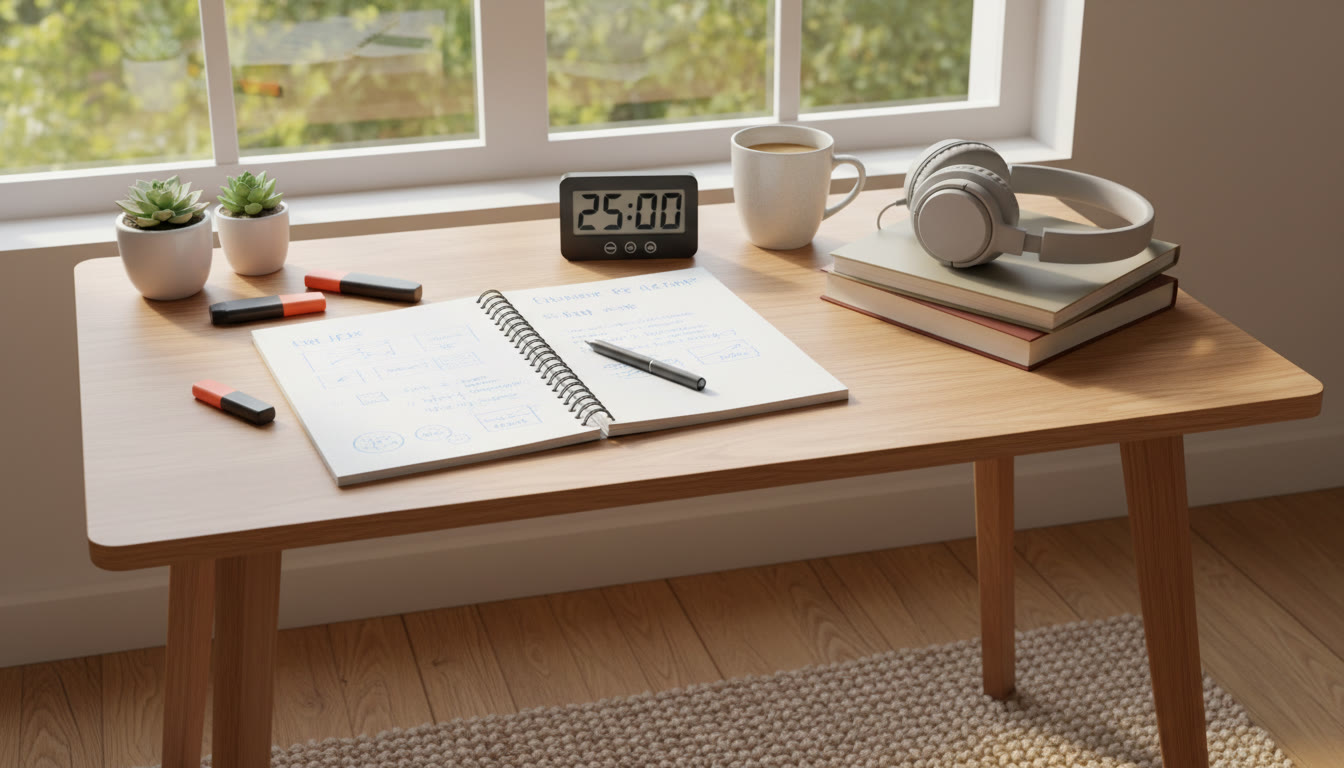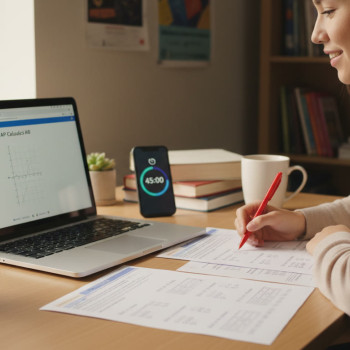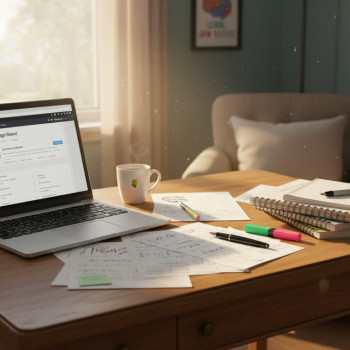Why Noise and Distraction Matter (Especially for AP Students)
AP courses demand a higher level of focus: denser content, faster pacing, and exams that reward depth and clear thinking. But the world around you doesn’t always cooperate. A creaky door, a sibling’s playlist, notifications on your phone — tiny interruptions add up and can quietly wreck a study session. This post walks you through why distractions matter, what actually works to reduce them, and how to create a study routine that protects your concentration without turning your life into a hermit’s cave.
The real cost of interruptions
Research on attention shows that when you switch tasks — even for a few seconds — your brain needs time to reorient. Those seconds become minutes, and minutes pile up across a study block. For AP students, that means lost opportunities to connect concepts, practice problem-solving, and build the kind of muscle memory that makes exam questions feel familiar instead of frantic.
Start with Your Space: Simple Environmental Fixes That Work
You don’t need a perfect room to study well, but making a few deliberate changes can transform how often you get pulled away.
Designate a ‘Study Spot’ — even if it’s small
Pick one place as your primary study zone. Consistency trains your brain: the space becomes a signal that it’s time to work. It can be a corner of your bedroom, a kitchen table, or a public library carrel. The goal is predictability.
Quick physical adjustments
- Clear the surface of clutter — visual noise is still a distraction.
- Control light: natural light when possible, task lighting for focused reading.
- Manage temperature: a room that’s too hot or too cold saps concentration.
- Ear protection: foam earplugs or closed-back headphones remove a surprising amount of background noise.

Sound Strategies: Use Sound to Block Sound
Counterintuitive but effective: the right predictable sound can reduce the impact of unpredictable interruptions.
White noise, pink noise, and ambient sound
White noise machines or apps can smooth out sudden spikes in sound (doors slamming, conversations) by filling the room with a gentle, constant backdrop. Pink noise and nature sounds are often perceived as less harsh and may help some students study longer with fewer disruptions.
Instrumental music and concentration playlists
If silence feels like pressure, choose instrumental tracks — piano, lo-fi beats, or ambient electronic — at a low volume. Lyrics engage the language centers of your brain and can interfere with reading or writing tasks, so save vocal-heavy music for chores or exercise.
Time Design: Structures That Protect Deep Work
Even with a quiet room, the clock can be your best defense against wandering attention. Time-based techniques create protected windows where distraction is less likely to win.
The Pomodoro technique — but make it yours
The classic Pomodoro (25 minutes work / 5 minutes break) is popular for a reason: it reduces the mental friction of starting and gives frequent, guilt-free breaks. For AP study — particularly complex problem solving or dense readings — you might prefer longer intervals: try 50/10 or 45/15 depending on task difficulty.
Task batching and theme days
- Batch similar activities (problem sets, reading, note review) so context switching is minimized.
- Assign themes to study blocks: “Biology morning” and “Calculus evening.”
Digital Discipline: Tame Your Devices Without Going Cold Turkey
Your phone isn’t the enemy — your relationship with it might be. With a few habits and small tech adjustments you can keep devices from dictating your attention.
Practical phone controls
- Turn off nonessential notifications or use Do Not Disturb during study blocks.
- Use app timers to limit social media bursts to break periods.
- Put your phone in another room during critical study sessions or place it face down in a drawer.
Use apps to help, not hurt
Focus apps can block distracting sites during study windows, and productivity tools can track how you spend time on tasks. Consider apps that log your sessions rather than shaming you — the point is data, not guilt.
Social Solutions: Managing People Without Drama
Noise often comes from the people who share your space — family, roommates, or friends. Communicating boundaries kindly is an essential skill in the real world and during AP season.
Set expectations, not ultimatums
Try a short, specific request: “I have a study block from 4–6 PM for my AP Calculus test next week; can we keep the TV off while I’m working?” Clear times and an explanation of stakes (exam date, assignment weight) make cooperation more likely.
Create a signal system
Use a ‘do not disturb’ sign, a colored light, or even headphones as a nonverbal cue. Over time, everyone in the house will learn your signals and respect the rhythm.
On-the-Run Focus: Studying in Imperfect Places
Not everyone has access to a private room or silent library. If you study in noisy common areas or on the bus, these tactics help you extract productive minutes out of imperfect settings.
Portable tools that help
- Noise-cancelling headphones (even budget options) make a big difference on commutes or in cafeterias.
- Digital flashcards and short AP Daily videos are perfect for 10–20 minute bursts of focused review.
- Record quick voice notes to yourself summarizing what you learned — audio review can be surprisingly effective.
Mental Habits: Build Attention Like a Muscle
Focus is less of a binary switch and more of a muscle you can exercise. Intentional mental routines will make your attention more resilient to noise.
Start with a 2-minute ritual
Before each study block, take two minutes to breathe, set one specific goal (e.g., “complete five AP Physics problems”), and write it down. That tiny ritual helps the brain shift from ‘reactive’ to ‘deliberate.’
Practice mindful refocusing
When you notice your mind wandering, don’t judge it. Pause, note what distracted you, and gently return to the task. Over time, your recovery becomes faster.
Practical Exam-Day Tips: When Silence Matters Most
Exam day is high stakes and sometimes noisy. Preparation beforehand reduces the chance that unexpected distractions will throw you off.
Simulate testing conditions
Do at least two full-length timed practice exams in a quiet room that mimics the testing environment: desk, limited movement, and a clock visible. Practicing under similar constraints trains both your mind and body to perform when it counts.
Bring your tools
- Eye mask or earplugs (if allowed and comfortable).
- Watch with a clear face so you can track time without relying on room clocks.
Sample Weekly Plan: A Noise-Aware AP Study Schedule
Structure helps reduce the decision fatigue that leads to distraction. Here’s an example schedule that balances deep work, review, and recovery for a typical AP student with multiple courses.
| Day | Morning | Afternoon | Evening |
|---|---|---|---|
| Monday | 50-min focused study (AP Biology) + 10-min break | Review notes in 25-min bursts; practice questions | Group study or discussion |
| Tuesday | Practice FRQs for AP English (timed) | Lab write-up / problem set with noise-cancelling headphones | Light review and relaxation |
| Wednesday | AP Calculus deep work: problem set | Short mixed-subject flashcards on commute | Mock timed section |
| Thursday | Concept mapping and connections | One-on-one tutoring session or focused review | Reflection and planning |
| Friday | Timed practice multiple-choice | Peer review or group quiz | Free evening to recharge |
| Weekend | Full-length practice exam (Saturday) | Catch-up and targeted weak-point drills | Active rest: exercise, hobbies |
Why this helps
Clear blocks reduce the number of times you need to decide what to do, which in turn reduces opportunities for distraction. Pairing focused sessions with short breaks keeps your brain fresh and resilient.
When You Need Extra Help: Personalized Support That Fits Your Noise Reality
Sometimes the problem isn’t just strategies — it’s about building a plan that’s tailored to your schedule, household dynamics, and the specific demands of your AP courses. This is where personalized tutoring can be a game-changer.
How one-on-one support helps
A good tutor doesn’t just explain content — they help you design study windows, pick the best practice problems, and coach you through distractions. Working with an expert tutor can shorten your mistake cycle, provide accountability, and give you tools to manage noisy study environments more effectively. For example, Sparkl’s personalized tutoring offers 1-on-1 guidance, tailored study plans, and AI-driven insights that help highlight weaknesses and recommend focused practice — exactly the kind of support that makes noisy study time more productive.
Quick Fixes You Can Use Right Now
If you have five minutes before a study block, try one of these micro-habits to reduce distraction immediately:
- Put your phone in another room and set a timer for your study interval.
- Put on instrumental music or white noise and close the door.
- Write down three study goals for the session: specific, short, and measurable.
- Tell one roommate or family member your plan and the time you’ll be undisturbed.
- Take a deep breath and do two minutes of focused breathing to center your attention.
Common Scenarios and Ready-Made Plans
Here are practical, scenario-specific suggestions you can implement immediately.
Scenario: Sibling noise after school
- Plan study blocks before siblings come home, or use noise-cancelling headphones after school.
- Ask for a 60-minute quiet window and trade favors (you’ll help with dinner prep later).
Scenario: Shared bedroom
- Create a visual queue (lamp on = studying, lamp off = free to chat).
- Use a foldable screen or desk organizer to create a micro-boundary on your desk.
Scenario: Small apartment with roommates
- Coordinate a shared calendar for quiet hours during high-stakes weeks (AP testing season).
- Rotate quiet times so everyone gets fair access to uninterrupted study blocks.
Measuring Success: How to Know Your Anti-Noise Plan Works
It’s easy to try something and forget whether it helped. Use simple measures to track effectiveness and iterate.
Three practical metrics
- Session completion rate: Did you finish the planned focused sessions this week?
- Quality of work: Are fewer careless mistakes appearing in practice problems?
- Recovery time: How quickly can you return to focus after an interruption?
Keep a short weekly log: time studied, number of interruptions, and a quick note on productivity. Small data helps you make small, useful changes.
Final Thoughts: Build a Study Life That Respects Your Needs
Preparing for AP exams is a marathon made up of many short sprints. You’ll have noisy days and quiet days. The point isn’t to eliminate every distraction — that would be impossible — but to create a system that protects your best thinking when it matters. Combine environmental tweaks, time strategies, digital boundaries, and social communication, and you’ll go a long way toward transforming frustrating study hours into productive ones.
If you want tailored help building a study plan that fits your home life and exam timelines, consider exploring personalized tutoring — a short season with an expert can teach you tricks that save hours of wasted study time. Services that offer 1-on-1 guidance, tailored study plans, and AI-driven insights can be especially helpful for busy AP students who need targeted, efficient practice.

Parting encouragement
Learning to manage noise is a skill you’ll use long after AP exams: in college classrooms, study groups, and workplaces. Start small, be patient with your progress, and celebrate the sessions you own — a strong study life is built moment by moment. You’ve got this.
Ready to try a new approach? Pick one tactic from this post and use it for a week. Track your progress and adjust. Small experiments lead to big wins.
























No Comments
Leave a comment Cancel